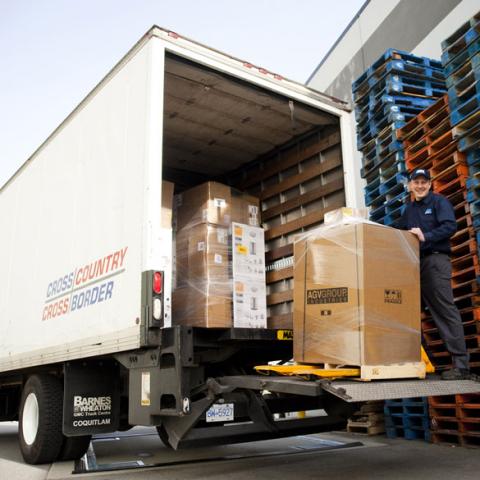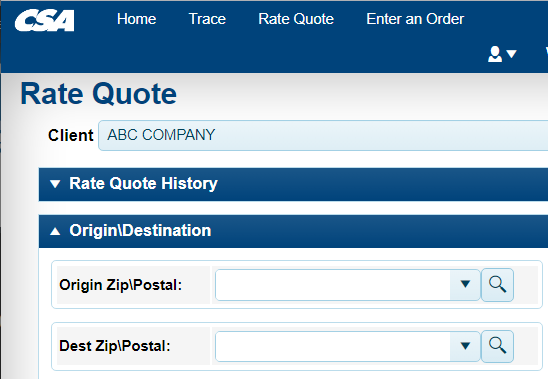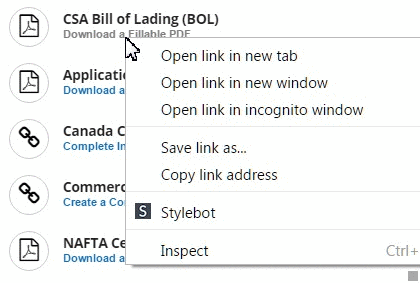Standard Pallet Size & Dimensions
If you ship large quantities of goods, or ship large or heavy goods that need to be protected during transfer and safely delivered then chances are you will use pallets at some point in the supply chain to do this. Using pallets makes shipping more secure and, more importantly, is the most cost effective way at maximizing space in truck trailers.
The best LTL freight rates can be obtained by transporting goods throughout North America using pallets. With standard pallet sizes it is easy to calculate how much your shipping is going to cost from a single pallet to muliple pallets. Your carrier will be happy too, as this method of shipping eases the handling and storage space needed, pallets occupy a volume of-space as well as floor space and they can be packed easily with a forklift to maximizy warehouse and trailer space. Overall using pallets is one of the more efficient ways to ship and deliver.
Carriers that use pallet pricing typically use a standard pallet of 48" x 40" x 96" ( L x W x H) for rating. They will usually set a max weight (1650lbs for example) and set their base rates according to this.
What is the size of a Standard Pallet?
In North America the standard pallet dimensions of 48" x 40" have been popular since the 1960s and is on the ISO (International Organization for Standardization) approved standard pallet size list. Pallet size varies around the world, Europe has a standard pallet size, as does Asia and North America. For suppliers of fast-moving consumer goods (FMCG) the GMA pallet (Grocers Manufacturers Association) is considered the standard pallet size dimension, in North America.
Having said this, pallet size can vary according to the type of products being shipped. While the standard pallet size of 48" x 40" may be used for grocery products and many others, the next most common size is a 42" x 42” pallet, which is commonly used to ship articles such as paint. The third most common pallet size is the 48” x 48” pallet which is commonly used for larger containers such as drums. The retail industry often opts for the half pallet (48” x 20”) as they find it benefits supply and sales.
There are so many options available it is probably best to communicate the exact pallet size to your suppliers or shippers so that there are no misunderstandings or surprises when goods arrive at their warehouse. This way they are prepared and know beforehand if they have the right equipment necessary to handle the goods.
Common Pallet Types and Their Uses
The standard pallet sizes talked about above should help in deciding what pallet best suits your product or industry, however, it is not only about pallet size or dimension – if only! There are many, many types of pallets made from varying materials and with standard pallet heights, width and thickness which need to be considered.
The two most common types of pallets used in North America are:
- Stringer Pallet – so called because it uses boards (called stringers) to support the weight of the load. The stringer boards are sandwiched between the top and bottom layer of boards. (You may sometimes see what appears to be a stringer pallet being referred to as a “Skid” pallet – this is simply a stringer pallet without a bottom deck). A 4-way stringer pallet is common, and simply means that it has a four-way entry for the forklift. Otherwise, a 2-way pallet, as the name suggests, has forklift entry from only two sides.
- Block Pallets - Block Pallets have 4-way entry allowing for mechanical lifting on all four sides. Solid wood, plastic or plywood is typically used. The standard formation would be 4-12 blocks which support the top boards. A block pallet can be made either with a bottom deck or without.
Both these types of pallets can have variations in deck board dimensions and configurations where spacing between boards or the number of boards vary. Other variations may be in the type of materials used, where variants from plywood to oriented strand board can be used and sometimes synthetic foam can be used instead of blocks, when cushioning is needed for the goods.
Best Materials to Use for Pallets
While variations of the standard pallet exist using materials from plastic to wood, the default pallet for most companies is the wooden pallet for a number of reasons:
Easy loading and unloading - saving time and money
Reusable
Recyclable
Non-toxic – very important for transport of foods and consumable goods
They are commonly available
Pallet FAQs
With all the information out there about pallets, how do I know which is the right pallet for my business? You should speak to your carrier who will help you with this important decision. Together you will decide on the best size for the products you ship. Pallet size consideration is determined by the volume of your goods and how much they weigh.
Do all pallets weigh the same?
The weight of the pallet will depend on the type of material used in the pallet, if it is made of wood then the moisture content of the wood needs to be considered too. Having said that, a standard pallet weighs between 30 – 48 lbs.
What can I do with my unused pallets?
Usually your supplier of pallets will have a service where they pick-up unused pallets – so you don’t have a warehouse full of empty pallets. Some suppliers leave a trailer at your warehouse and when filled with empty pallets they pick it up.
How much can a pallet hold?
In terms of weight a standard pallet can hold up to 4,600lbs
Remember that wooden pallets can be recycled and reused and with people becoming more environmentally aware it is always something to be mindful of. Fun Fact: The lifespan of a standard pallet is 7 years!!
Bring in the Pallet Shipping Experts with CSA Transportation
Pallet Shipping is a crucial aspect of the transportation industry that helps businesses move their goods across different locations. Palletized goods are transported over highways and intercity routes delivering commodities and finished products to companies and consumers. The trucking industry employs over 7 million people in the United States and moves more than 70% of all pallets.
CSA Transportation is a reliable and experienced pallet shipping company that offers top-notch services to its clients.
Businesses must consider experience, capacity, equipment, cost, safety, and security factors when choosing a freight hauler. With 15 distribution centers throughout the US and Canada, CSA Transportation offers an unbeatable combination of service and price for shipping freight from Canada to the US.
We offer same-day pick-ups and departures, simplified pricing, and provide online tracking tools and email notifications. Since 1986, CSA has kept supply chains humming and amassed many loyal customers along the way.
Contact CSA Transportation today to learn more about freight hauling near me and how they can support your business's transportation needs.






